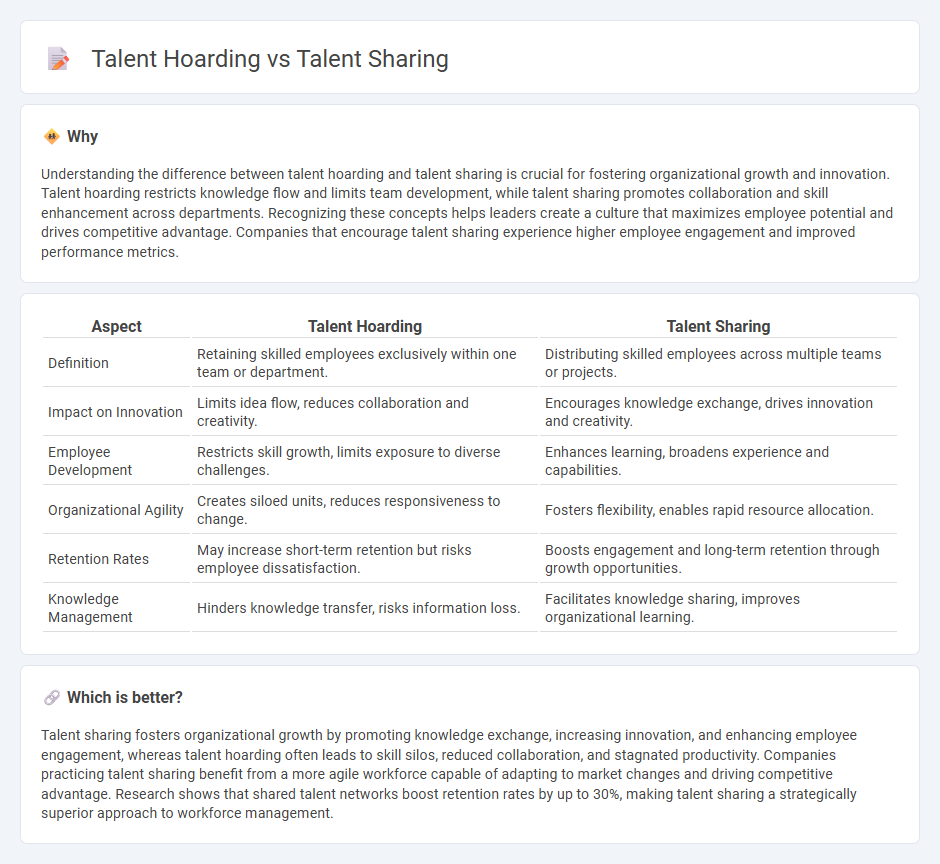
Talent hoarding occurs when organizations or individuals retain skilled employees to maintain competitive advantages, often limiting collaboration and knowledge exchange. In contrast, talent sharing promotes resource efficiency and innovation by enabling workforce mobility and cross-organizational partnerships. Discover how balancing talent hoarding and sharing can transform business growth and workforce development.
Why it is important
Understanding the difference between talent hoarding and talent sharing is crucial for fostering organizational growth and innovation. Talent hoarding restricts knowledge flow and limits team development, while talent sharing promotes collaboration and skill enhancement across departments. Recognizing these concepts helps leaders create a culture that maximizes employee potential and drives competitive advantage. Companies that encourage talent sharing experience higher employee engagement and improved performance metrics.
Comparison Table
| Aspect | Talent Hoarding | Talent Sharing |
|---|---|---|
| Definition | Retaining skilled employees exclusively within one team or department. | Distributing skilled employees across multiple teams or projects. |
| Impact on Innovation | Limits idea flow, reduces collaboration and creativity. | Encourages knowledge exchange, drives innovation and creativity. |
| Employee Development | Restricts skill growth, limits exposure to diverse challenges. | Enhances learning, broadens experience and capabilities. |
| Organizational Agility | Creates siloed units, reduces responsiveness to change. | Fosters flexibility, enables rapid resource allocation. |
| Retention Rates | May increase short-term retention but risks employee dissatisfaction. | Boosts engagement and long-term retention through growth opportunities. |
| Knowledge Management | Hinders knowledge transfer, risks information loss. | Facilitates knowledge sharing, improves organizational learning. |
Which is better?
Talent sharing fosters organizational growth by promoting knowledge exchange, increasing innovation, and enhancing employee engagement, whereas talent hoarding often leads to skill silos, reduced collaboration, and stagnated productivity. Companies practicing talent sharing benefit from a more agile workforce capable of adapting to market changes and driving competitive advantage. Research shows that shared talent networks boost retention rates by up to 30%, making talent sharing a strategically superior approach to workforce management.
Connection
Talent hoarding restricts organizational growth by limiting the flow of skilled employees, while talent sharing promotes innovation and efficiency across teams. Companies practicing talent sharing benefit from enhanced collaboration, increased knowledge transfer, and a stronger overall workforce. Understanding the balance between hoarding and sharing talent is critical for optimizing employee engagement and business performance.
Key Terms
Collaboration
Talent sharing fosters a culture of collaboration by enabling employees to exchange skills and expertise across teams, enhancing innovation and productivity. In contrast, talent hoarding limits organizational growth by confining knowledge within silos and reducing overall efficiency. Explore strategies to promote talent sharing and drive collaborative success within your organization.
Resource Allocation
Talent sharing enhances resource allocation by enabling organizations to deploy skilled employees across projects where their expertise delivers the highest impact, reducing redundancies and optimizing workforce utilization. Talent hoarding often leads to resource bottlenecks and missed opportunities as departments retain top performers instead of reallocating them to where they are most needed. Discover how strategic talent sharing transforms resource management and drives organizational agility.
Knowledge Transfer
Talent sharing drives effective knowledge transfer by encouraging collaboration and open communication across teams, fostering innovation and continuous learning. Talent hoarding restricts information flow, limiting organizational growth and creating silos that hinder performance. Discover how embracing talent sharing strategies can transform knowledge transfer and elevate your company's competitive edge.
Source and External Links
Skills-based hiring and talent sharing - TestGorilla - Talent sharing is the practice of sharing employee skills across teams, departments, geographies, or subsidiaries to promote professional growth, job rotation, and boost motivation and retention through a skills-first mindset.
A Guide to Talent Sharing - SSR - Talent sharing involves the flexible sharing of employees and their skills within or between organizations to gain insights, improve skill development, and is distinct from structured job rotation programs.
The Inside Gig: How Sharing Untapped Talent Across Boundaries ... - Talent sharing requires a mindset shift from scarcity to abundance, enabling organizations to quickly access and deploy internal talent, enhancing productivity, learning, and employee engagement.
 dowidth.com
dowidth.com